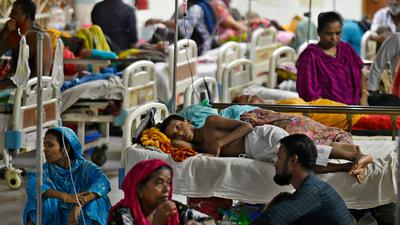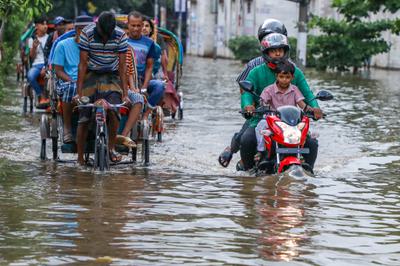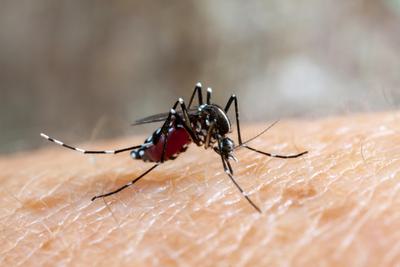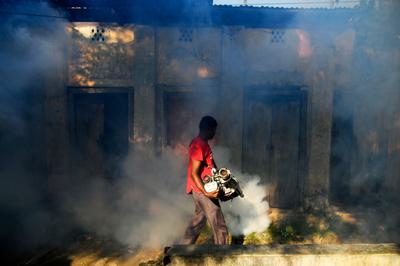A World Health Organization official called recent dengue outbreaks a “canary in the coal mine of the climate crisis.”
This year’s dengue outbreaks have not been restricted to Bangladesh. More than 4.5 million cases and 4,000 deaths related to dengue have been reported this year, through the beginning of November, from 80 countries. More than half of those cases were in South America, with epidemics in Brazil, Peru, and Bolivia, but there were also outbreaks in South and Southeast Asian countries, including Sri Lanka, Thailand, and Vietnam.
Dengue infections have been rising in tropical and subtropical regions for the past two decades: Cases reported to the World Health Organization (WHO) increased from about half a million in 2000 to 5.2 million in 2019. Improved diagnostics and reporting explain much of this jump, but a combination of population growth, increasing urbanization and travel, and climatic changes is also boosting Aedes mosquitoes, which drives up transmission in existing hotspots and spreads it toward new areas at both higher latitudes and higher altitudes. In recent years, dengue has popped up in places it had never been seen, including Afghanistan, parts of Southern Europe, and, this year, Chad.
In July, a senior WHO official flagged the role of rising temperatures and humidity levels — in addition to this year’s El Niño — calling the outbreaks a “canary in the coal mine of the climate crisis.” About half the world’s population is already exposed to dengue risk; a 2019 climate modelling study projected that under a moderate warming scenario, an additional 2 billion people would be at risk of dengue exposure by 2080, compared to 2015.
Bangladesh’s crisis is thus “a wake-up call,” especially for South Asia, said Ayesha Mahmud, a health demographer specializing in infectious disease at the University of California, Berkeley. “Understanding the impact of these drivers of dengue transmission will be crucial for forecasting outbreaks in the future,” she added, “particularly in the context of predicted climatic changes, such as increases in mean temperatures across the tropics and the intensification of the monsoon season.”
A warming and urbanizing world has been good for A. aegypti, the main vector of the dengue virus. According to the 2020 Lancet Countdown on Health and Climate Change, rising global temperatures between 1950 and 2018 increased the climate suitability for the transmission of the dengue virus by almost 9 percent for A. aegypti and 15 percent for A. albopictus.
As temperatures continue to rise, more areas will become habitable for these mosquitoes. “In the future, the belt of transmission is going to continue expanding northwards and upwards,” said Felipe Colón-González, a climate and health expert at the Wellcome Trust, a global charitable foundation based in the U.K. “There’s going to be more months that are going to be suitable for transmission, and because people are likely to travel more, there’s also going to be more opportunities for moving the mosquitoes and moving the disease to different areas.”
In Bangladesh, dengue season could become longer as winter temperatures rise, leading to outbreaks at any time of the year.
The biggest increase in cases, said Colón-González, is expected in Southeast Asia — especially parts of Malaysia, Indonesia, the Philippines, Vietnam, and some areas of the Indian subcontinent — and in South America, particularly Brazil. Although population growth and urbanization will play bigger roles in boosting risk, higher temperatures can increase mosquito population density, their biting rate, and even their flying distances, studies have shown.
In higher-warming scenarios, however, some areas in India, Bangladesh, and Thailand, among others, could become less suitable for A. aegypti, resulting in a decline in cases in the second half of the century, according to Colón-González’s climate modeling. The optimal temperature range for Aedes mosquitoes is thought to be 77 to 86 degrees F (25 to 30 degrees C).
Experts also expect more cases in parts of Africa, though projections for that region are difficult to make due to the lack of health data. Areas unfamiliar with dengue may be hard hit even if case numbers aren’t high, Colón-González warns, as people won’t have immunity from previous exposure to the virus, and public health systems may not be strong enough to cope with dengue outbreaks. Even where health systems are strong, such as in Southern Europe or the United States — which has recorded 1,874 cases in 2023, as of November 8 — doctors may not be able to identify the disease. “Health care providers should learn to recognize this disease at an early stage,” says the Centers for Disease Control and Prevention.
Warmer temperatures could also expand the season for transmission. A 2021 study exploring future risk for Bangladesh found that the dengue season could become longer as winter temperatures rise, leading to “outbreaks occurring at any time of the year.”
Changes in rainfall can also shape outbreak risk, as Bangladesh saw this year. Increased rain means there is more stagnant water in which mosquitoes can breed, though deluges can also wash larvae away. And reduced rainfall can lead communities to store water, which creates opportunities for mosquitoes to breed. Researchers have also linked El Niño, a climate phenomenon that brings heavy rain to some places, with increased incidence of dengue in Colombia and with outbreaks in Venezuela.
Dengue is often considered an urban disease because A. aegypti thrives in cities, breeding even in tiny amounts of water and feeding on a large human population. However, a recent study by Colón-González and others looking at transmission dynamics in Southeast Asia found that densely populated urban areas may be at lower risk compared to surrounding or developing rural areas, perhaps because highly developed cities are likely to be wealthier and have better infrastructure — from trash collection to water access — than newly urbanizing areas.
Being infected with one strain of dengue does not provide immunity to others, and a second infection can cause more severe disease.
In the study, higher GDP turned out to have a protective effect against dengue. Colón-González points to the difference in dengue incidence in cities on either side of the U.S.-Mexico border. “The number of cases on the Mexican side is more than 100 times bigger than on the U.S. side, even if they share the same climate,” he said. “People [in the U.S.] have more adaptive capacity. They have access to air conditioning, [which] reduces humidity and temperature and the survival of mosquitoes.”
A post-pandemic increase in construction activity may also be playing a role in the Bangladesh outbreaks, said Kabirul Bashar, an entomologist and a member of the government anti-dengue committee, because stagnant water can collect in the trenches and shafts of building sites. Rapid and unplanned urbanization also means that many areas don’t have a regular water supply, forcing people to store water, he noted. These areas may not have proper waste management systems either, leading to large quantities of litter that collect water in close proximity to homes. In the capital of Dhaka, for instance, research has found mosquitoes breeding in everything from discarded tires and refrigerator trays to plastic drums and construction waste.
A worker sprays insecticide in a crowded neighborhood in Dhaka to protect against dengue fever, July 18, 2023. Syed Mahamudur Rahman / NurPhoto via Getty Images
Recent years have also seen more cases reported from beyond Bangladesh’s capital region. In 2023, cases have been reported from every district in the nation, with more cases outside Dhaka than within. The spatial expansion may also help explain the higher death toll, as previously unexposed populations get infected in areas without adequate health infrastructure.
The death toll may also be explained by the presence of four different serotypes, or strains, of the dengue virus circulating in the region. Since 2019, the dominant strain of dengue in Bangladesh has been DENV-3. But DENV-4 emerged in last year’s outbreak, and the highly virulent DENV-2 is reported to have dominated cases this year, after a hiatus of four years. Being infected with one strain does not provide immunity to others, and a second infection can cause more severe disease, raising the risk of death. “When a new serotype is introduced in a population that previously experienced epidemics of other serotypes, we might see worse outcomes and more severe cases in the population,” said Mahmud, of UC Berkeley.
The large outbreaks in recent years may have their own knock-on effect. “The evolution of the virus happens faster when there is massive spread and new serotypes [emerge], which in turn leads to massive endemic outbreaks,” says Neelika Malavige, global head of the dengue program at the nonprofit Drugs for Neglected Diseases initiative (DNDi).
Insecticides can be helpful, but studies have found that many mosquitoes in Dhaka have become resistant to commonly used pesticides.
Researchers are ramping up their efforts to find solutions. Traditionally, communities have focused on vector control — reducing the chances of a mosquito bite by promoting the use of window screens and bed nets or trying to eliminate mosquitoes entirely with insecticide sprays. But because Aedes is active during the day — unlike the malaria-carrying Anopheles — bed nets are of limited use, experts note. Spraying insecticides on breeding sites can be helpful, said Bashar, but studies have found many mosquitoes in Dhaka have become resistant to commonly used pesticides. He believes better waste disposal and regular water supply are critical to reducing mosquito breeding.
From a health perspective, experts say improved disease surveillance and public health infrastructure will be needed to detect cases early. In recent years, researchers have been trying out early warning systems to forecast outbreaks using models that integrate factors like rainfall and population density. Such a system has been tried with some success in Colombia; Colón-González’s team is testing a warning system in Vietnam. And two vaccines recently became available, though they can’t be used without confirming, via a lab test, whether a patient has previously been infected with dengue.
For its part, DNDi is focused on finding treatments for the disease, which has been historically neglected by the pharmaceutical sector. In August, it announced a partnership with institutions in India, Thailand, Malaysia, and Brazil with the aim of finding a safe and affordable therapy within the next five years. Noting that vector control has not been able to stop the spread of dengue beyond endemic countries, DNDi South Asia director Kavita Singh called for more funding to develop treatments and diagnostics. “Coordinated action is needed to fight dengue,” she said.






